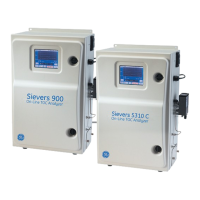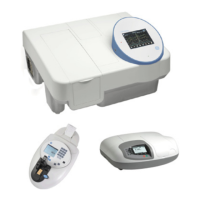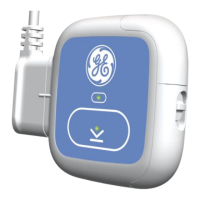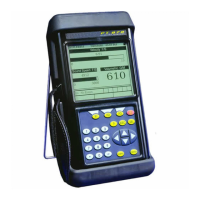GE Analytical Instruments ©2010 59 of 226 DLM 74001-04 Rev. A
Chapter 3: Installation
18. Slide the DI water cartridge into the bracket and rotate it into the retaining clip until it snaps into place.
19. Add water to the DI water cartridge, if necessary.
20. Replace the rubber inlet cover.
21. Turn the Analyzer on and wait 1 minute.
22. Check the level of the DI water cartridge. If the water level has dropped below the Full line, remove the
rubber inlet cover from the top of the cartridge, add more water, and replace the inlet cover.
23. Close the Analyzer’s front panel.
24. Push the Main button and then press the Menu button.
25. Continue to Step 8. Note that even if you choose to skip Step 8, you must complete Step 9, “Rinsing the
Analyzer,” prior to putting the Analyzer on-line.
Step 8: Configure Basic Analyzer Settings
Before using the Analyzer, you will need to configure various basic settings. Some of these settings will not need
to be changed again, unless you move the Analyzer or reconfigure the operational environment.
Enabling DataGuard or Password Protection (Optional)
The Sievers 500 RL On-Line TOC Analyzer offers two levels of security, one included with the Analyzer and the
other available for purchase as an upgrade from GE Analytical Instruments. The Password Protection feature is
included with the Analyzer and provides a basic level of security. DataGuard™ is available as an upgrade
directly from GE Analytical Instruments and provides support for the electronic signature regulation 21 CFR Part
11. You can enable one of these security features, but not both. (See Chapter 5: Password Protection and
DataGuard for more information.)
If you purchased the DataGuard firmware feature from GE Analytical Instruments or will be using basic
Password Protection, enable the feature now.
If you will not be using DataGuard or Password Protection, proceed to “Setting the Clock and Time Zone” on
page 61.
Enabling Password Protection
If you will be using basic Password protection rather than DataGuard, activate the password now by following
the steps below. Note that if DataGuard will be activated, there is no need to additionally activate the Password
feature and you can proceed to the next section.
1. Select the DataGuard tab.
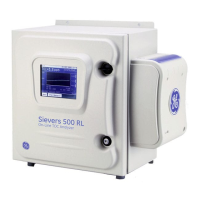
